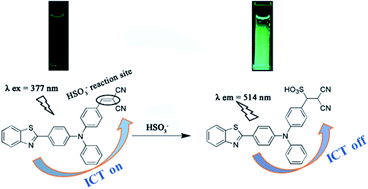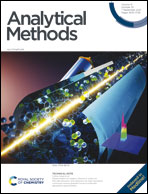A novel fluorescent probe based on a triphenylamine derivative for the detection of HSO3− with high sensitivity and selectivity†
Abstract
A novel highly active fluorescence chemical sensor (TBQN) for HSO3− was synthesized by the Knoevenagel reaction based on triphenylamine–benzothiazole as a new fluorophore. The probe possessed good selectivity toward HSO3− and anti-interference ability with common ions. The fluorescence and UV-vis spectra of the TBQN probe were significantly changed after the addition of HSO3−. At the same time, the probe solution released obvious green fluorescence. Moreover, the limit of detection for HSO3− was calculated to be 3.19 × 10–8 M. The TBQN probe displayed a rapid response to HSO3− and it took about 3 min to complete the recognition. The detection mechanism is the nucleophilic addition reaction between HSO3− and –C![[double bond, length as m-dash]](https://www.rsc.org/images/entities/char_e001.gif) C– in the probe molecule. The π-conjugation and ICT (intramolecular charge transfer) transition in the TBQN molecule were destroyed by this addition, which resulted in the change of the fluorescence before and after the addition of HSO3−. Then, the mechanism was verified by theoretical calculations, 1H NMR measurements and mass spectroscopy. In addition, the probe showed low cytotoxicity and could be used for biological imaging in RAW264.7 cells.
C– in the probe molecule. The π-conjugation and ICT (intramolecular charge transfer) transition in the TBQN molecule were destroyed by this addition, which resulted in the change of the fluorescence before and after the addition of HSO3−. Then, the mechanism was verified by theoretical calculations, 1H NMR measurements and mass spectroscopy. In addition, the probe showed low cytotoxicity and could be used for biological imaging in RAW264.7 cells.

- This article is part of the themed collection: Analytical Methods HOT Articles 2021


 Please wait while we load your content...
Please wait while we load your content...